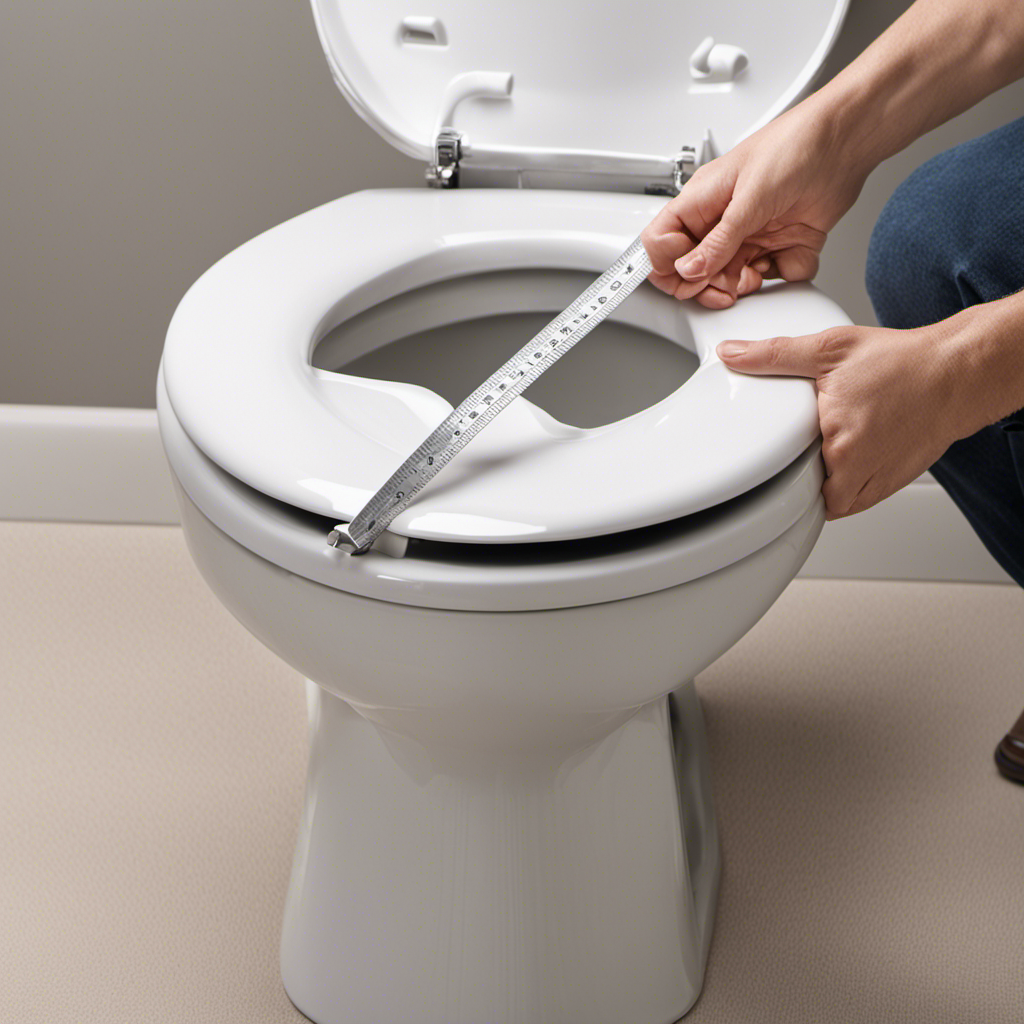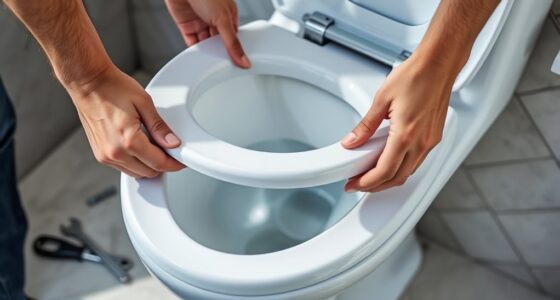So you’re in the market for a new toilet, but before you make a purchase, you need to know the height.
Don’t worry, measuring toilet height is easier than you might think. In this article, we’ll guide you through the precise steps of measuring both the bowl and seat height, determining the rough-in size, and calculating the overall toilet height.
We’ll even delve into ADA compliance and other important factors to consider.
So grab your measuring tape and let’s get started!
Key Takeaways
- Gathering the necessary tools for measuring toilet height
- Factors affecting seat height
- Determining the rough-in size
- Importance of accurate measurements for the right fit and proper functionality
Step 1: Gather the Necessary Tools
First, you’ll need to gather the necessary tools for measuring the toilet height. To accurately determine the height of your toilet, you’ll require a measuring tape, a level, and a pencil or marker.
The measuring tape will allow you to measure the distance from the floor to the top of the toilet tank or seat. Ensure that the tape is taut and straight to obtain accurate measurements.
The level will help you ensure that the toilet is perfectly level before taking any measurements. This step is crucial as an uneven toilet can result in inaccurate height measurements.
It’s important to avoid common mistakes such as not using a level or using a tape that is not straight, as these can lead to inaccurate readings.
Once you have gathered these tools, you can proceed to step 2: measure the bowl height.
Step 2: Measure the Bowl Height
Next, you’ll need to determine the height of the bowl. This step is crucial in finding the right toilet for your needs. To accurately measure the bowl height, follow these measuring techniques and avoid common mistakes:
| Measuring Technique | Common Mistakes |
|---|---|
| Measure from floor to rim | Not accounting for thickness of toilet seat |
| Measure from floor to top of bowl | Not measuring at the highest point of the bowl |
To measure from floor to rim, place a measuring tape on the floor, against the base of the toilet. Extend the tape up, ending at the highest point of the rim. Ensure that you take into account the thickness of the toilet seat for accurate measurements. To measure from floor to top of the bowl, follow the same steps but measure to the highest point of the bowl instead. By using these measuring techniques and avoiding common mistakes, you can accurately determine the height of the toilet bowl.
Step 3: Measure the Seat Height
To ensure optimal comfort and usability, it’s important to measure the seat height accurately.
There are a few key points to consider when measuring the seat height. First, you need to determine the optimal seat height for the user’s comfort and posture. This will vary depending on the individual, but generally, the seat height should allow the user’s feet to rest flat on the ground while their knees are at a 90-degree angle.
Next, you should follow some tips for achieving accurate measurements. It’s best to have the user sit on the chair while you measure the seat height. Use a tape measure or ruler to measure the distance from the ground to the highest point of the seat.
Finally, there are factors that can affect the seat height. The type of chair or surface the chair is placed on can impact the seat height. For example, a chair with wheels may have a different seat height than a stationary chair. Additionally, if the chair is placed on a thick carpet or a thin rug, it can affect the overall height.
Optimal Seat Height
The optimal seat height for a toilet is typically determined based on the user’s comfort and accessibility needs. When it comes to optimal seat design, there are several comfort factors to consider:
-
Ergonomics: The seat should provide proper support to your body, ensuring that you can sit comfortably without straining your back or legs.
-
Height adjustability: A toilet seat with adjustable height allows users of different heights and mobility levels to find the most comfortable position.
-
Padding: A soft and cushioned seat can enhance comfort, especially for individuals with sensitive skin or those who spend a significant amount of time on the toilet.
-
Stability: The seat should be securely attached to the toilet bowl to prevent any wobbling or shifting, providing a stable and safe seating experience.
Measuring Accuracy Tips
For accurate measurements, make sure you’re using a reliable tape measure and taking into account any variations in the floor or wall surfaces. When measuring the height of a toilet, it is important to use proper techniques to ensure accuracy.
First, ensure that the tape measure is securely placed against the ground and the top of the toilet seat. Avoid any gaps or misalignments that could affect the measurement.
Additionally, pay attention to any common mistakes such as measuring from the wrong points or not considering the thickness of the toilet seat. These errors can lead to inaccurate measurements and ultimately affect the comfort and usability of the toilet seat.
Now that you understand the importance of accurate measurements, let’s explore the factors that can affect seat height.
Factors Affecting Seat Height
Make sure you consider the various factors that can impact the height of your seat. Adjusting seat height is crucial for achieving optimal comfort while using the toilet. Here are some factors that you should take into account:
-
Body proportions: Everyone has different body proportions, and these can affect the ideal seat height. Consider your leg length and the angle at which your knees bend when sitting.
-
Mobility limitations: If you have any mobility limitations, such as difficulty bending your knees or getting up from a low seat, you may need to adjust the seat height accordingly.
-
Personal preference: Some people simply prefer a higher or lower seat height based on their personal comfort preferences. Experiment with different heights to find what works best for you.
-
Health conditions: Certain health conditions, such as arthritis or back problems, may require specific seat heights to minimize discomfort and strain.
Considering these factors will help you determine the ideal seat height for your comfort. Now, let’s move on to step 4: determining the rough-in size.
Step 4: Determine the Rough-In Size
To measure the rough-in size, you’ll need a flexible measuring tape. This is an essential step in determining the proper placement of your toilet during installation.
The rough-in size refers to the distance between the center of the drainpipe and the finished wall. To accurately measure this, start by locating the center of the drainpipe. Then, measure from this point to the finished wall. Make sure to account for any baseboards or other obstructions.
The most common rough-in sizes are 10, 12, and 14 inches. However, it’s important to consult your toilet installation specifications to determine the exact rough-in size required for your specific model.
Taking accurate measurements will ensure a proper fit and prevent any future issues with your toilet installation.
Step 5: Measure the Overall Toilet Height
When it comes to selecting a toilet, finding the optimal height is crucial for comfort and accessibility. Accurate measurements play a significant role in ensuring that the toilet height is suitable for your needs.
Optimal Toilet Height
You’ll want to ensure that the toilet height is optimal for your comfort and ease of use. Having the right toilet height can provide numerous benefits and make a significant difference in your overall bathroom experience.
Here are a few key points to consider:
-
Increased Accessibility: Optimal toilet height allows for easier sitting and standing, especially for individuals with mobility issues or disabilities.
-
Improved Posture: The right toilet height promotes better posture, reducing strain on your back, hips, and knees.
-
Enhanced Safety: A properly adjusted toilet height reduces the risk of accidents and falls, especially for older adults or those with balance issues.
-
Customizable Options: Many toilets offer height adjustment features, allowing you to find the perfect height that suits your individual needs.
When considering toilet height, remember to measure the overall height accurately and adjust it accordingly for maximum comfort and convenience.
Importance of Accurate Measurements
Accurate measurements are crucial for ensuring the right fit and proper functionality of your toilet. Precision is key when it comes to measuring the height of your toilet, as even a slight miscalculation can result in discomfort or inconvenience. To emphasize the importance of precision, let’s take a look at some common measurement mistakes and their potential consequences:
| Measurement Mistake | Consequence |
|---|---|
| Measuring too high | Difficulty in reaching the seat |
| Measuring too low | Uncomfortable seating position |
| Uneven measurements | Instability and wobbling |
Step 6: Consider ADA Compliance and Other Factors
It’s important to consider ADA compliance and other factors when measuring toilet height. ADA compliance ensures that toilets are accessible for individuals with disabilities, promoting inclusivity and equal access.
When measuring toilet height, it’s crucial to take into account the following considerations:
-
ADA Compliance Guidelines: The ADA sets specific height requirements for toilets, including the height of the seat and the grab bars. These guidelines help ensure that individuals with disabilities can use the toilet safely and comfortably.
-
User Requirements: It’s important to consider the needs and preferences of the users. Some individuals may require a higher or lower toilet height based on their physical abilities and limitations.
-
Alternative Toilet Height Options: In addition to standard toilet heights, there are alternative options available, such as comfort height toilets that are slightly taller than regular toilets. These options provide additional comfort and convenience for users.
-
Safety and Accessibility: Proper toilet height is crucial for preventing accidents and ensuring accessibility. It’s important to measure and adjust the toilet height accordingly to meet safety and accessibility standards.
Considering these factors will help ensure that the toilet height is suitable for all users, promoting inclusivity and accessibility.
Conclusion
In conclusion, measuring the height of a toilet is a straightforward process that requires a few simple steps. By gathering the necessary tools and carefully measuring the bowl and seat height, as well as the overall toilet height, you can ensure an accurate measurement.
While ADA compliance and other factors should be considered, these measurements provide the technical, precise, and detailed information needed for any toilet-related project.
Don’t let the perception of complexity deter you; with a little effort, you can confidently measure your toilet’s height and proceed with confidence.










